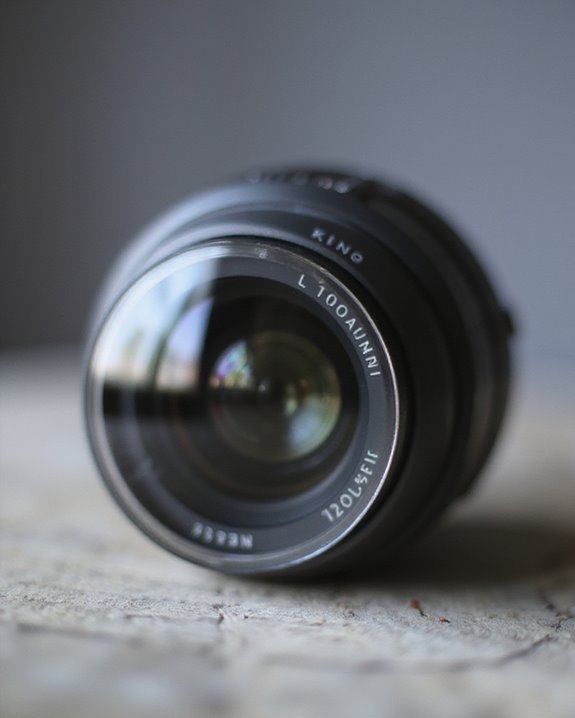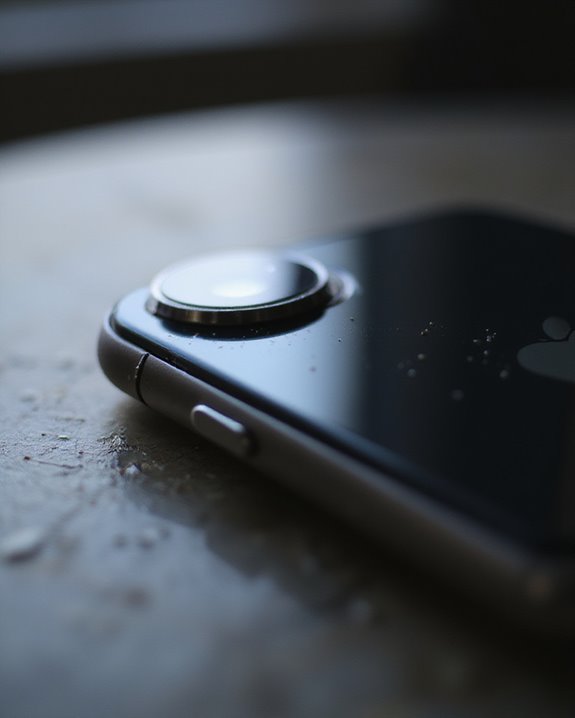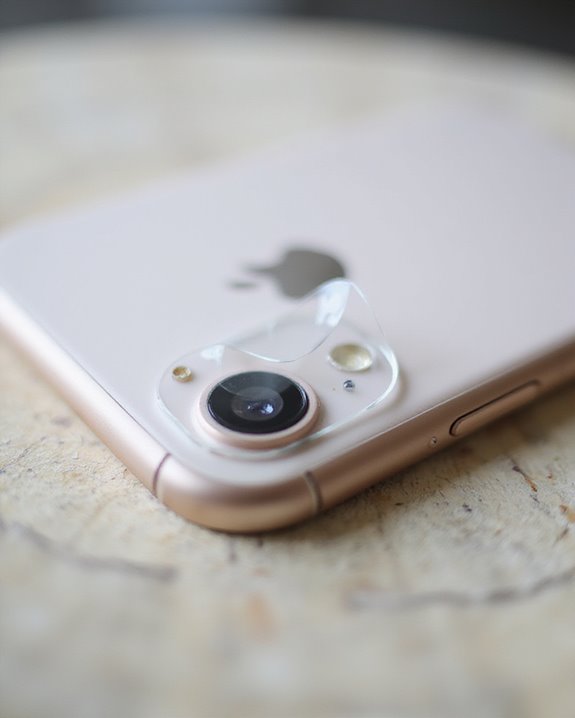Camera lens protectors can affect image quality, though the impact varies by type and quality. High-quality protectors using multi-coated tempered glass maintain 90-99% light transmission with minimal distortion, while budget options may introduce glare, color shifts, and reduced clarity. Proper installation is essential, as bubbles or misalignment can create visible artifacts. The trade-off between protection and optical performance depends greatly on manufacturing precision and materials used. Further exploration reveals important distinctions between premium and budget options.
Key Takeaways
- High-quality protectors maintain transmission rates above 99.75%, with most photographers detecting no brightness differences.
- Poor installation can create air gaps, dust particles, or misalignment that significantly degrades image quality.
- Budget protectors may introduce glare, color shifts, and reduced contrast compared to premium options with multi-coating technology.
- Protectors typically cause 1-5% light transmission loss in low-light conditions, potentially affecting night photography.
- Multiple stacked filters compound light loss and increase the risk of vignetting, particularly with wide-angle lenses.
The Science Behind Lens Protectors
The fundamental purpose of lens protectors lies in their carefully engineered design to shield camera lenses from potential damage while maintaining optical performance. Recent Protector Research indicates that high-quality filters utilize advanced optical glass with precise coatings to minimize light interference, allowing photographers to safeguard equipment without compromising image quality. According to Lens Physics principles, properly manufactured protectors maintain the original lens characteristics with minimal distortion or light refraction.
The effectiveness of protectors varies considerably based on manufacturing quality and installation precision, with premium filters demonstrating negligible impact on optical clarity. While inexpensive protectors may introduce unwanted artifacts such as flaring or reduced sharpness, professional-grade options maintain image integrity through multi-coating technology that reduces reflections and preserves light transmission capabilities, particularly in challenging shooting conditions.
Material Quality and Its Impact on Image Clarity
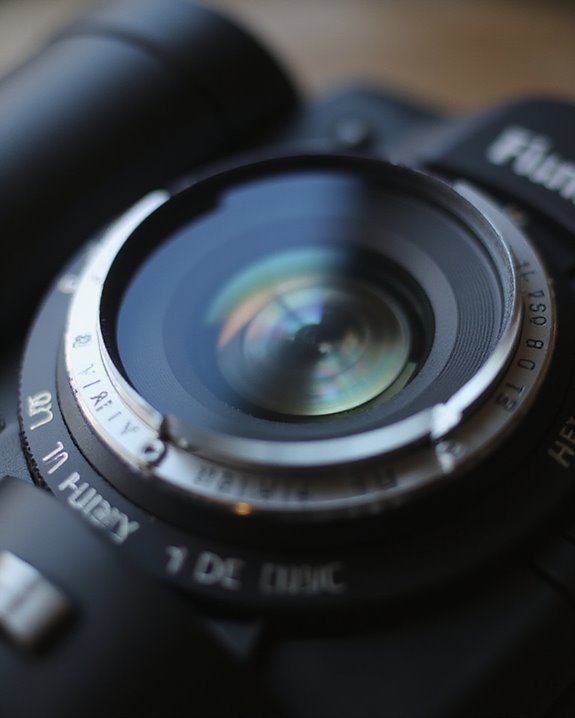
Material quality serves as the primary determinant of a lens protector’s impact on image clarity, with significant variations across product categories affecting photographic results. Tempered glass protectors, particularly those with multi-layer AR coatings, maintain 90-99% light transmission and resist Thermal Effects that can cause expansion and warping. In contrast, polyurethane and PET films offer more Flexibility Impact for curved lenses but often develop haze over time, gradually reducing contrast in images. Manufacturing precision also plays a critical role, as CNC-cut protectors with optical-grade polishing minimize light diffusion and internal refraction artifacts. The price spectrum generally reflects these quality differences, with premium options ($15-30) incorporating chemically strengthened glass that preserves optical properties under daily wear conditions, while budget alternatives commonly introduce noticeable glare and color shifts.
How Installation Affects Picture Results
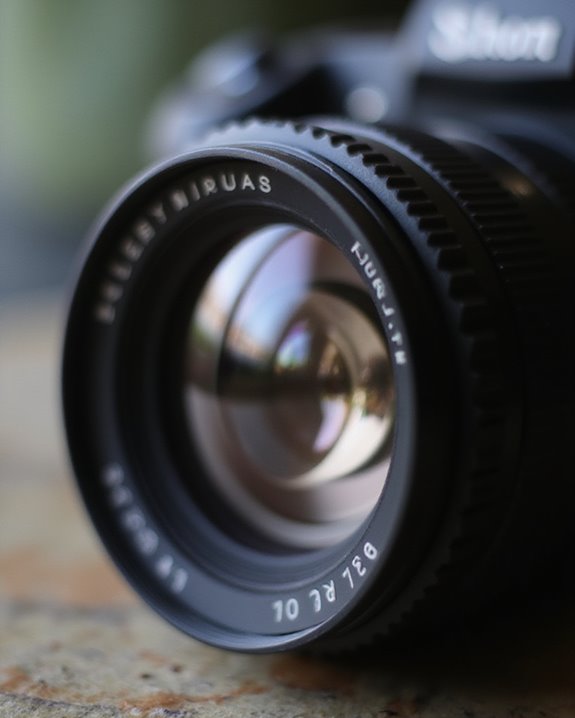
Properly installing a lens protector critically determines whether image quality remains pristine or becomes compromised, with even minor installation errors potentially undermining the camera’s optical performance. Precise alignment and centering prevent vignetting and guarantee the field of view remains unobstructed, while thorough pre-installation cleaning eliminates dust particles that could create visible artifacts in images. Bubble prevention techniques, including proper pressure application and use of installation guides, maintain ideal light transmission and prevent distracting glare issues. Using nano-electrostatic adhesion technology ensures a residue-free and secure attachment, further preserving photo clarity. Edge sealing plays an essential role in preventing environmental contaminants from seeping beneath the protector over time. Installation should occur in controlled, dust-free environments with good lighting to spot imperfections immediately. After installation, compatible protective cases and proper handling prevent shifting that could compromise the carefully established optical alignment.
Light Transmission and Brightness Considerations
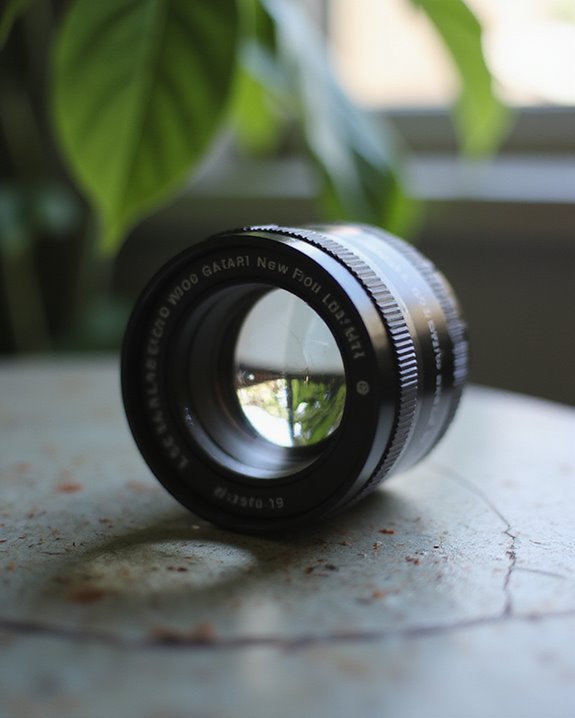
Beyond installation quality, light transmission represents a fundamental consideration when evaluating camera lens protectors’ impact on image quality. Any additional glass element introduces potential light loss, with high-quality protectors featuring multi-coated surfaces minimizing this effect to nearly imperceptible levels. Perception tests reveal that most photographers cannot detect brightness differences when using premium protectors, which maintain transmission rates above 99.75%. Quantitative measurement confirms that well-made protectors with ultra-low reflectivity coatings preserve image brightness effectively across the visible spectrum. Additionally, protectors utilizing advanced multi-layer optical processing technology further reduce glare and enhance clarity, ensuring optimal photo quality. The greatest light transmission concerns emerge when using low-quality protectors or stacking multiple filters, which compounds light loss. Physical factors like scratches and fingerprints further scatter light, reducing contrast and apparent brightness. In challenging lighting conditions, such as backlit scenes, even minor transmission reductions may become more noticeable.
Anti-Reflective Properties and Glare Reduction
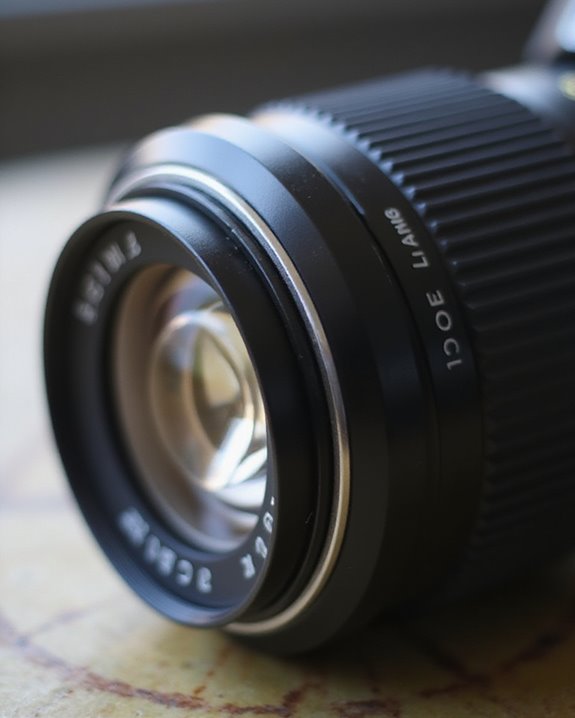
Anti-reflective properties represent an essential feature in camera lens protectors that directly impacts image quality and shooting performance. High-quality protectors utilize nano-coating technologies that reduce surface light scattering, minimizing haze while enhancing contrast in challenging lighting conditions. When capturing Wildlife, Glare reduction becomes particularly critical, allowing photographers to maintain visibility and composition integrity even in direct sunlight. Additionally, many advanced protectors incorporate light transmittance technologies that ensure minimal loss of brightness and color accuracy. In Studio Effects photography, anti-reflective coatings prevent unwanted interference patterns that might appear when protector quality mismatches lens optical parameters. Advanced ion-exchange glass treatments offer superior protection while maintaining ideal clarity, though installation precision remains vital for preventing air gaps that could distort images. User experiences consistently indicate that premium anti-reflective protectors, such as those featuring Nanoarmour technology, preserve photo quality in bright conditions while resisting degradation over time, which budget options often fail to maintain.
Color Accuracy With Different Protector Types
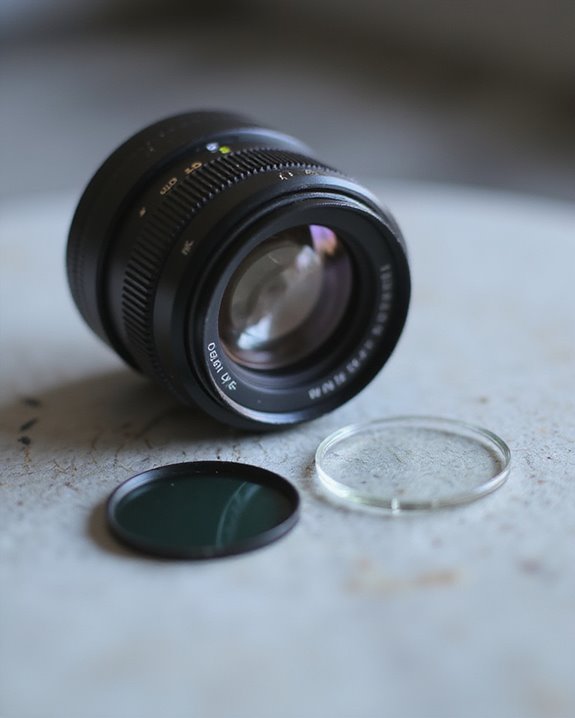
While anti-reflective coatings tackle light interference issues, color accuracy represents another significant factor photographers must consider when selecting lens protectors. The material quality and manufacturing precision directly influence how faithfully colors are reproduced, affecting both Color Psychology and Artistic Interpretation in final images.
Sapphire glass protectors generally offer superior color fidelity due to their exceptional optical clarity, whereas polymer-based options may introduce subtle color shifts if not precisely manufactured. High-transparency materials without tints are essential for maintaining true color representation. Glass protectors typically outperform plastic alternatives in preserving natural color vibrancy.
Users should prioritize protectors with anti-color shift coatings and those manufactured with Tiffen’s Color Core method or similar technologies that guarantee color accuracy. Avoiding cheap alternatives and selecting lab-tested products will minimize unwanted color casts that could compromise artistic vision.
Environmental Protection Benefits
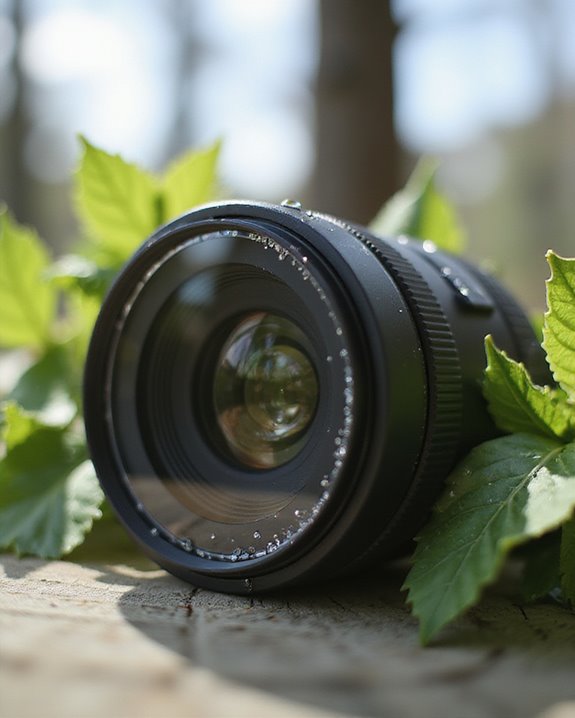
Photographers operating in varied conditions recognize that lens protectors serve purposes extending far beyond image quality considerations. Camera lens protectors create physical barriers against environmental hazards, providing essential Weather Protection by shielding lenses from rain, snow, and other moisture that could otherwise damage optical elements. Lens hoods, wraps, and UV filters work in conjunction to maintain equipment integrity during challenging outdoor shoots.
Dust Resistance represents another significant benefit, as protectors prevent small particles from settling on lens surfaces, which would otherwise degrade image clarity and potentially cause permanent scratching. UV filters act as frontline defenses, while lens wraps offer additional protection during transportation and storage. The cushioning properties of these accessories also provide impact protection against minor knocks and falls, especially valuable when shooting in harsh conditions where camera handling becomes difficult.
Balancing Scratch Resistance With Visual Quality

The fundamental challenge in lens protection exists in the balance between scratch prevention and maintaining optical fidelity. Tempered glass with 9H hardness offers excellent scratch resistance while preserving light transmission, though thermal effects can cause slight expansion that impacts edge clarity over time. High-quality protectors maintain transmission rates above 90% through anti-reflective coatings that minimize glare without compromising image quality.
Surface smoothness at Ra <0.01μm proves critical for preventing micro-distortions, with vibration control becoming increasingly important as protector thickness increases beyond 0.3mm. Multi-layer construction combines scratch resistance with impact dispersion while minimizing vignetting on wide-angle lenses. The trade-off becomes most apparent in low-light conditions, where even premium protectors introduce 1-5% light transmission loss, requiring photographers to balance durability against subtle optical compromises.
Premium vs. Budget Protectors: The Quality Difference
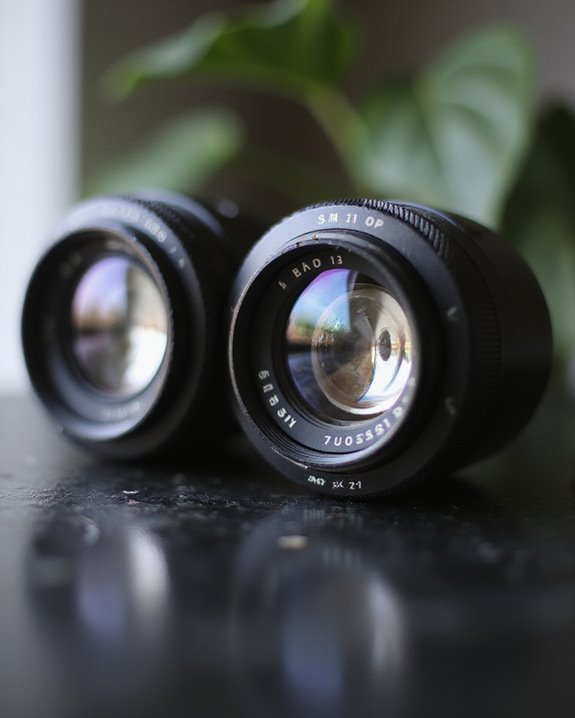
Significant differences in material composition, optical quality, and long-term durability separate premium lens protectors from their budget counterparts in today’s smartphone camera market. Premium options utilize tempered glass with specialized coatings that maintain 90-99% light transmission, while budget alternatives often employ lower-grade materials that introduce image softness and color shifts. Aesthetic Differences extend beyond appearance, as premium protectors feature oleophobic coatings that resist fingerprints and maintain clarity longer than their budget counterparts. Compatibility Variations also emerge in installation experiences, with premium products typically including precise alignment tools that guarantee bubble-free application. The price differential ($13-20+ versus substantially less for budget options) often reflects not merely brand premium but tangible performance advantages that professional photographers and serious enthusiasts may find essential for preserving image integrity.
Frequently Asked Questions
Can Lens Protectors Interfere With Autofocus Performance?
Through the crystal-clear eye of a camera, lens protectors can indeed cast shadows on performance. Low-quality or improperly installed protectors may cause AF interference and compromise focus stability during critical shooting moments.
How Often Should Camera Lens Protectors Be Replaced?
Camera lens protectors typically need replacement every 3-12 months, depending on material quality. Users should monitor for wear signs like scratches, cracks, or clouding. High-quality glass protectors follow a longer replacement schedule than plastic ones.
Do Protectors Affect Night Photography or Low-Light Shooting?
Like shadows concealing truth, lens protectors greatly impair night photography by reducing light transmission. This necessitates higher ISO settings, introducing noise. Additional concerns include lens fogging between layers and interference with sensor heating during prolonged exposures.
Are Lens Protectors Compatible With Polarizing Filters?
Lens protectors are fully compatible with polarizing filters. The filter attachment process remains unaffected as protectors are designed with threads to accommodate additional filters while maintaining maximum optical clarity in the final image.
Can Temperature Extremes Cause Protectors to Detach or Crack?
Like ice surrendering to sunlight, lens protectors can succumb to temperature extremes. Thermal shock and material fatigue from repeated expansion/contraction cycles may cause protectors to crack or detach from their mounting threads.

